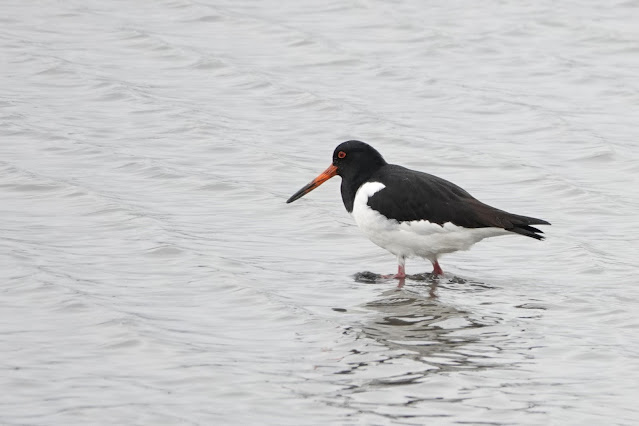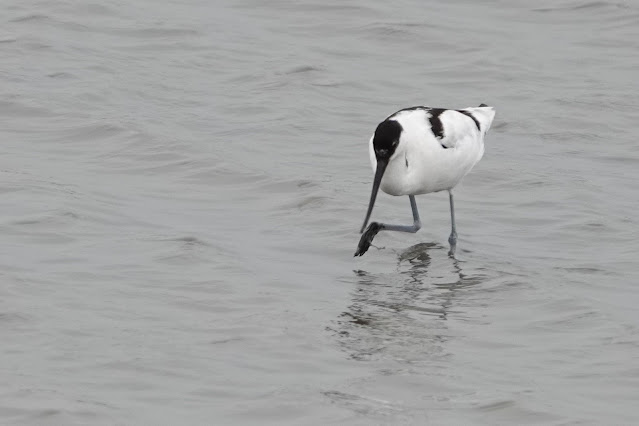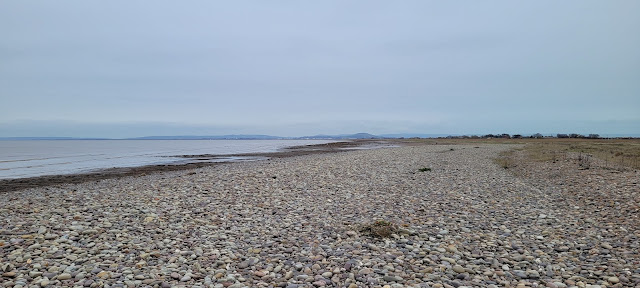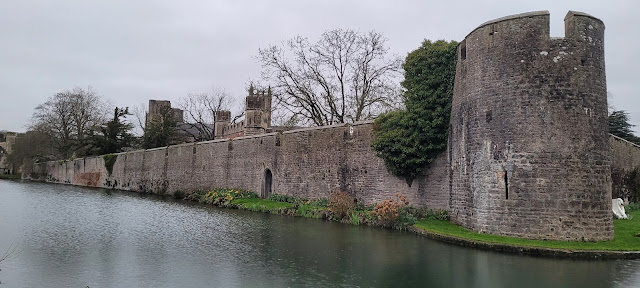It had been very cold overnight and there was a heavy frost
on the playing fields and just a few redwings huffing cold breath into the
still air. Greenfinches were wheezing
around the Speech House car park as we packed up and de-iced the van. I had decided that Goldcliff would be given a
miss in favour of the other side of the Bristol Channel and headed down to
Chepstow and then over the bridge and down to Bridgewater so that we could get
to Steart Marshes before high tide. The
weather was a complete mixed bag on the drive down but we still added a few
species to the trip list including Rooks, Herring Gulls and a couple of M5
Cattle Egrets!
The usual wiggling took us to the car park passing Yellowhammer
and a some Redwings in the lanes before a squidge across the salt marsh to the
cobble bank over looking the sea. Skylarks
sang all around despite the dreary conditions and Meadow and Rock Pipit, Linnet
and Reed Buntings were all seen as we crossed over.
The tide was most of the way in but there were still flocks
of Curlew to be found along with Turnstone, Oystercatcher, Dunlin, Grey Plover
and Redshank to at long last give us some waders. Shelduck bobbed offshore and a couple of Kestrels
and Marsh Harriers were seen over the fields.
.jpg) |
| Grey Plover, Turnstone and Redshank - Andy Buck |
Back at the main car park we
headed off into the light spitty rain towards the Quantock Hide encountering a
fine pylon Raven on the way along with Cetti’s Warblers, Reed Buntings and a
few explosive Redwings.
The first Marsh Marigold was in flower and I pointed out the
Cigar Galls of Lipara lucens – a small fly whose larva live inside the
Phragmites stems and cause the plant to react accordingly. It is a little like the moth larva wiggle of Stigmella
aurella on Bramble as once seen you can’t unsee it and will find almost without
thinking!
 |
| Marsh Marigold |
.jpg) |
| Lipara lucens - Andy Buck |
.jpg) |
| Lipara lucens |
Similarly the exploding heads of Greater and Lesser Reedmace (it is not Bullrush!) contained the larva of Limnaecia phragmitella and those of Teasel, one of the
two Endothenia species of moth larvae.
The guests can certainly say that we did not only do birds!
 |
| Endothenia sp |
 |
| Limnaecia phragmitella signs |
Down at the hide the very same immature Spoonbill that I saw
in January was still dozing out front but amazingly was joined almost
immediately by a fully plumed adult that circled. We retreated into the hide
for a more comfortable view and watched both shuffle positions before the
characteristic snoozing position was taken up.
.jpg) |
| Spoonbills - Andy Buck |
.jpg) |
| Spoonbill - Andy Buck |
Three immaculate Icelandic Black-tailed Godwits in full
breeding finery were out front along with Redshank, Oystercatchers and about 50
Avocet but not one Lapwing. The Little Ringed
Plovers eluded us but we did have four Golden Plover fly over. The ‘missing’ dabbling ducks of Teal, Gadwall
and Shoveler were added too.
.jpg) |
| Avocet - Andy Buck |
 |
| Oystercatcher |
 |
| Icelandic Black-tailed Godwits and Redshank |
 |
| Avocet and Teal |
 |
| Avocet |
 |
| Teal |
 |
| Icelandic Black-tailed Godwits |
 |
| Icelandic Black-tailed Godwits and Redshank |
I always have a cursory look through the big gulls but was
not expecting to find a very smart 1w Caspian Gull on the Spoonbill
island. I ticked off all the salient
features with my crew and the two hide guides before we continued on our way.
 |
| 1w Caspian Gull |
Two Brown Hares fed silently in the meadow behind the wicker
hare sculpture and Stonechat popped up briefly in the rain while a female
Kestrel diligently hovered for her lunch.
She was very wet and I only hope that she caught something and could
seek some shelter.
 |
| Brown Hares |
 |
| Wicker Hares |
 |
| Kestrel |
 |
| Kestrel |
Back at the van, Sam the warden came over to ask about the
Caspian Gull. Thankfully he saw it
later. A new Somerset bird for him and the first site record. Apologies to any locals for not getting the
news out.
 |
| Starlings |
.JPG) |
| Starlings |
A fairly direct route back through Bridgewater took us onto
the M5 once again and a little further south before cutting into towards
Langport and Swell Wood. It was raining
again but we persevered with the upper woodland path (I could not face the road
hill!) as it said that there was a view point.
They lied as the trees have obviously grown a bit since the map was made
but despite the obscured view and treacherously muddy track we managed to see
seven Cranes including two in the same spot as January and at least five Great
White Edots and two Roe Deer out on Sedgemoor.
.jpg) |
| Cranes - Andy Buck |
Despite the rain there was some time for botany with a few
Primroses and Lesser Celandines in flower along with singles of Sweet Violet
and Bluebell. The fly mine of Chromatomyia
aprilina on Honeysuckle was new to me.
 |
| Primroses |
 |
| Bluebell |
 |
| Lesser Celandines |
 |
| Chromatomyia aprilina on Honeysuckle |
Great Spotted Woodpeckers were drumming and Green
Woodpeckers were yaffling but I was delightfully surprised to hear the drumming
of a Lesser Spotted Woodpecker too, coming from the main section of the
wood. It was just too dreary and damp to
pick out on the tall Ash trees but it was a pleasing and educational encounter
none the less.
We all managed to get back to the van without incident
although we may have been transporting some of the forest floor mud around with
us by then. Margaret and Dave had found
the Heronry hide and its feeding station and we joined them for a relaxing sit
down with a host of small birds coming into feed. There were the expected five Tits including
sneezing Marsh Tits and greasy Coals and along with the Nuthatches there were
Treecreepers actually coming to the logs for suet pellets that had been put out
which was not something I had seen before.
.jpg) |
| Treecreeper - Andy Buck |
.jpg) |
| Treecreeper - Andy Buck |
.jpg) |
| Coal Tit - Andy Buck |
.jpg) |
| Long-tailed Tit - Andy Buck |
Up above Grey Herons noisily came and went from their seemingly
flimsy canopy nests and Rooks and Jackdaws added to the cacophony. Two local
photographers told us they had seen the male Lesser Spot just here the previous
week!
 |
| The heronry |
On now to Greylake passing two more brief Cattle Egrets
near Aller (could not stop) and a few roadside Great Whites, Ravens and Buzzards before
arriving at the little car park. We were
the only ones there. A pleasant hour was
spent watching the Teal, Shoveler, Wigeon, Gadwall and Pintail from the hide
although the vast numbers of January were somewhat depleted. At long last we found a couple of Lapwings and
there were several camo-Snipe amongst the peat clods while about 70 Golden Plover flew to some further fields.
.jpg) |
| Shoveler - Andy Buck |
.jpg) |
| Teal - Andy Buck |
.jpg) |
| Shoveler - Andy Buck |
 |
| Camo-Snipe |
 |
| Wigeon, Teal and Gadwall |
Great White Egrets moved to and from and at least seven were
seen including a fine breeding adult with a black bill and partially coloured
legs. It is odd how much small the bill looks
when it is dark and completely changed the profile of the bird in flight and on
the deck.
.jpg) |
| Great White Egret - Andy Buck |
Water Rail called from several spots and Cetti’s were
half-heartedly singing as the drizzle increased and the temperature
dropped. The warm and inviting Swan
Hotel in Wells beckoned although parking around there is something of a
challenge but at least where I ended up gave me the chance to walk past the moat
surrounding the imposing Bishops Palace before checking in.
Oh and the walk from the Coachhouse Rooms to the Reception was somewhat long and convoluted...
.jpg)

.jpg)
.jpg)


.jpg)
.jpg)
.jpg)













.JPG)
.jpg)




.jpg)
.jpg)
.jpg)
.jpg)

.jpg)
.jpg)
.jpg)


.jpg)











No comments:
Post a Comment